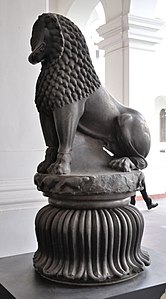Rampurva capitals
 Original bull capital of Rampurva, one of the Pillars of Ashoka, now located in the Presidential Palace of Rashtrapati Bhavan, New Delhi. 3rd century BCE. | |
| Location | West Champaran district, Bihar, India. |
|---|---|
| Coordinates | 27°16′11.75″N 84°29′58.08″E / 27.2699306°N 84.4994667°E |
| Type | Settlement |
The Rampurva capitals are the capitals of a pair of Ashoka Pillars discovered in c. 1876 by A. C. L. Carlleyle.[1][2] The archaeological site is called Rampurva, and is located in the West Champaran district of the Indian state of Bihar, situated very close to the border with Nepal.[3] The two capitals are in the Indian Museum in Kolkota.
Buddhist signification
Waddell in 1896 suggested that the death and parinirvana of Gautama Buddha was in the region of Rampurva: "I believe that Kusīnagara, where the Buddha died may be ultimately found to the North of Bettiah, and in the line of the Açōka pillars which lead hither from Patna (Pāțaliputra)."[4] Modern scholarship, based on archaeological evidence, believes that the Buddha died in Kushinagar (Uttar Pradesh).[5][6][7]
Rampurava lion capital

The lion pillar is inscribed with the Major Pillar Edicts of the Edicts of Ashoka, Pillar Edicts I, II, III, IV, V, VI.[8]
Rampurva bull capital
The Rampurva bull capital is noted as one of the seven remaining animal capitals from the Pillars of Ashoka. It is composed of a lotiform base, with an abacus decorated with floral designs, and the realistic depiction of a zebu bull.
The abacus in particular displays a strong influence of Greek art: it is composed of honeysuckles alternated with stylized palmettes and small rosettes.[9] A similar kind of capital can be seen at the basis of the Sankassa elephant capital. A similar frieze is also visible on the Diamond throne built by Ashoka at Bodh Gaya. These design likely originated in Greek and Near-Eastern arts.[10]
The bull is without inscriptions, presumably because its twin pillar, the Rampurava lion pillar already had them and therefore there was no need to repeat.[8] It is thought that the bull symbol is not related to the bull Nandi of Hinduism, as Ashoka was quite eclectic in his choice of animals for his pillars anyway: lions, elephants, camels, geese, and horses are known.[8]
-
Rampurva pillar excavation 1877.
-
Remains of the pillars today.
-
Original Rampurva bull up the stairs of Rashtrapati Bhavan, New Delhi.
| Rampurva capitals | |
| Lion capital |
|
| Bull capital |
|
See also
References
- ^ "Rampurva". Encyclopædia Britannica. Retrieved 7 October 2014.
- ^ Allen, Charles (2010). The Buddha and Dr. Führer: An Archaeological Scandal. Penguin Books India. pp. 66–67. ISBN 0143415743.
- ^ "Rampurva". Bihar Tourism. Retrieved 7 October 2014.
- ^ "A Tibetan Guide-book to the Lost Sites of the Buddha's Birth and Death", L. A. Waddell. Journal of the Asiatic Society of Bengal, 1896, p. 279.
- ^ United Nations (2003). Promotion of Buddhist Tourism Circuits in Selected Asian Countries. United Nations Publications. pp. 23–24. ISBN 978-92-1-120386-8.
- ^ Kevin Trainor (2004). Buddhism: The Illustrated Guide. Oxford University Press. p. 41. ISBN 978-0-19-517398-7.
- ^ Elizabeth Lyons; Heather Peters; Chʻeng-mei Chang (1985). Buddhism: History and Diversity of a Great Tradition. University of Pennsylvania Museum of Archaeology. p. 17. ISBN 978-0-934718-76-9.;
Fred S. Kleiner (2009). Gardner's Art through the Ages: Non-Western Perspectives. Cengage. pp. 13, 31. ISBN 0-495-57367-1. - ^ a b c Buddhist architecture, Huu Phuoc Le, Grafikol, 2010 p.36-40
- ^ "Buddhist Architecture" by Huu Phuoc Le, Grafikol, 2010, p.40 [1]
- ^ "Buddhist Architecture" by Huu Phuoc Le, Grafikol, 2010, p.44 [2]
















